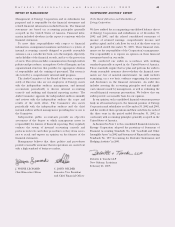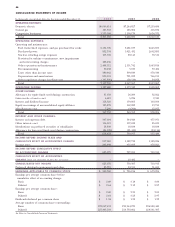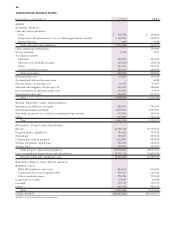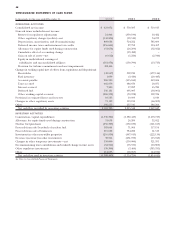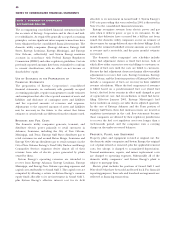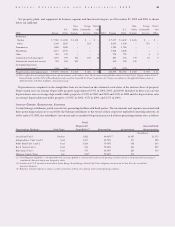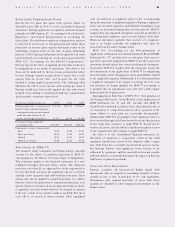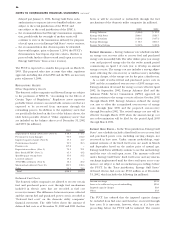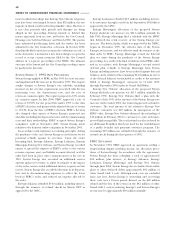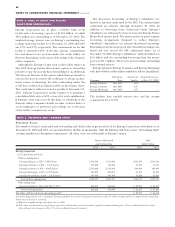Entergy 2002 Annual Report Download - page 55
Download and view the complete annual report
Please find page 55 of the 2002 Entergy annual report below. You can navigate through the pages in the report by either clicking on the pages listed below, or by using the keyword search tool below to find specific information within the annual report.
STOCK-BASED COMPENSATION PLANS
Entergy has two plans that grant stock options, which are
described more fully in Note 5 to the consolidated financial
statements. Entergy applies the recognition and measurement
principles of APB Opinion 25, “Accounting for Stock Issued to
Employees,” and related Interpretations in accounting for
those plans. No stock-based employee compensation expense
is reflected in net income as all options granted under those
plans have an exercise price equal to the market value of the
underlying common stock on the date of grant. Beginning
January 1, 2003, Entergy will prospectively apply the fair value
based method of accounting for stock options prescribed by
SFAS 123, “Accounting for Stock-Based Compensation.”
Entergy expects the effect of applying the fair value method to
be insignificant to its results of operations. The effect is less
than may be indicated by the pro forma presentation below
because Entergy expects prospectively to grant fewer stock
options than in recent years, and because the fair value
method is being applied prospectively. The following table
illustrates the effect on net income and earnings per share if
Entergy would have historically applied the fair value based
method of accounting to stock-based employee compensation
(in thousands, except per share data).
For the years ended December 31, 2002 2001 2000
Earnings applicable to common stock $599,360 $726,196 $679,294
Deduct: Total stock-based employee
compensation expense determined
under fair value method for all
awards, net of related tax effects 35,137 24,340 10,888
Pro forma earnings applicable
to common stock $564,223 $701,856 $668,406
Earnings per average common share:
Basic $2.69 $3.29 $3.00
Basic - pro forma $2.53 $3.18 $2.95
Diluted $2.64 $3.23 $2.97
Diluted - pro forma $2.48 $3.12 $2.92
APPLICATION OF SFAS 71
The domestic utility companies and System Energy currently
account for the effects of regulation pursuant to SFAS 71,
“Accounting for the Effects of Certain Types of Regulation.”
This statement applies to the financial statements of a rate-
regulated enterprise that meet three criteria. The enterprise
must have rates that (i) are approved by a body empowered to
set rates that bind customers (its regulator); (ii) are cost-based;
and (iii) can be charged to and collected from customers. These
criteria may also be applied to separable portions of a utility’s
business, such as the generation or transmission functions, or to
specific classes of customers. If an enterprise meets these criteria,
it capitalizes costs that would otherwise be charged to expense
if the rate actions of its regulator make it probable that those
costs will be recovered in future revenue. Such capitalized
costs are reflected as regulatory assets in the accompanying
financial statements. A significant majority of Entergy’s regulatory
assets, net of related regulatory and deferred tax liabilities, earn
a return on investment during their recovery periods. SFAS 71
requires that rate-regulated enterprises assess the probability of
recovering their regulatory assets at each balance sheet date.
When an enterprise concludes that recovery of a regulatory
asset is no longer probable, the regulatory asset must be
removed from the entity’s balance sheet.
SFAS 101, “Accounting for the Discontinuation of
Application of Financial Accounting Standards Board (FASB)
Statement No. 71,” specifies how an enterprise that ceases to
meet the criteria for application of SFAS 71 for all or part of its
operations should report that event in its financial statements.
In general, SFAS 101 requires that the enterprise report the
discontinuation of the application of SFAS 71 by eliminating
from its balance sheet all regulatory assets and liabilities related
to the applicable segment. Additionally, if it is determined that
a regulated enterprise is no longer recovering all of its costs
and therefore no longer qualifies for SFAS 71 accounting, it
is possible that an impairment may exist that could require
further write-offs of plant assets.
Emerging Issues Task Force (EITF) 97-4: “Deregulation of
the Pricing of Electricity - Issues Related to the Application of
FASB Statements No. 71 and 101” specifies that SFAS 71
should be discontinued at a date no later than when the effects
of a transition to competition plan for all or a portion of the
entity subject to such plan are reasonably determinable.
Additionally, EITF 97-4 promulgates that regulatory assets to
be recovered through cash flows derived from another portion
of the entity that continues to apply SFAS 71 should not be
written off; rather, they should be considered regulatory assets
of the segment that will continue to apply SFAS 71.
See Note 2 to the consolidated financial statements for
discussion of transition to competition activity in the retail
regulatory jurisdictions served by the domestic utility compa-
nies. Only Texas has a currently enacted retail open access law,
but Entergy believes that significant issues remain to be
addressed by regulators, and the enacted law does not provide
sufficient detail to reasonably determine the impact on Entergy
Gulf States’ regulated operations.
CASH AND CASH EQUIVALENTS
Entergy considers all unrestricted highly liquid debt
instruments with an original or remaining maturity of three
months or less at date of purchase to be cash equivalents.
Investments with original maturities of more than three
months are classified as other temporary investments on the
balance sheet.
ENTERGY CORPORATION AND SUBSIDIARIES 2002 53


